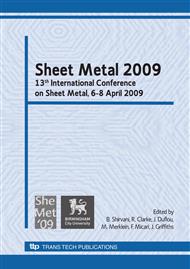p.595
p.601
p.611
p.621
p.629
p.643
p.661
p.669
p.679
Effect of Coiling Temperature on the Formation and Pickling Behaviour of Tertiary Scale on Hot-Rolled Carbon Steel Strip
Abstract:
Steel strips covered by a tertiary thermal oxide scale from a hot rolling process were studied in this research work. In case that the clean strip is required, i.e. for the cold rolling process, this tertiary scale formed on the steel surface is typically removed by a pickling process. In this work, a finishing temperature – the temperature at the exit of strip from a finishing mill – was kept constant at 830 °C. A coiling temperature – the temperature that the strip was coiled at a down coiler – was varied in a real hot rolling line to obtain different types of tertiary scales formed on low carbon steel strips. Physico-chemical characteristics and pickling behaviour of the scales were further investigated. It was found from a scanning electron microscope (SEM) that the thickness of scale at the centre of strip was in the range of 3-5 m and reduced with the decrease in coiling temperature. A laser Raman spectroscopy was also applied to make a depth profile of scale. Additionally, with the results observed from SEM and X-ray diffraction (XRD), it is concluded that the tertiary scale is a non-homogeneous single layer of a eutectoid structure consisting of magnetite and iron. Moreover, the samples were further immersed in a 10%v/v HCl pickling solution at 80 °C. It was found that the time needed to remove the tertiary scale was reduced with the decreased scale thickness, which was obtained by lowering the coiling temperature. Kinetics of scale removal during pickling is discussed in the paper.
Info:
Periodical:
Pages:
669-676
Citation:
Online since:
March 2009
Price:
Сopyright:
© 2009 Trans Tech Publications Ltd. All Rights Reserved
Share:
Citation:


